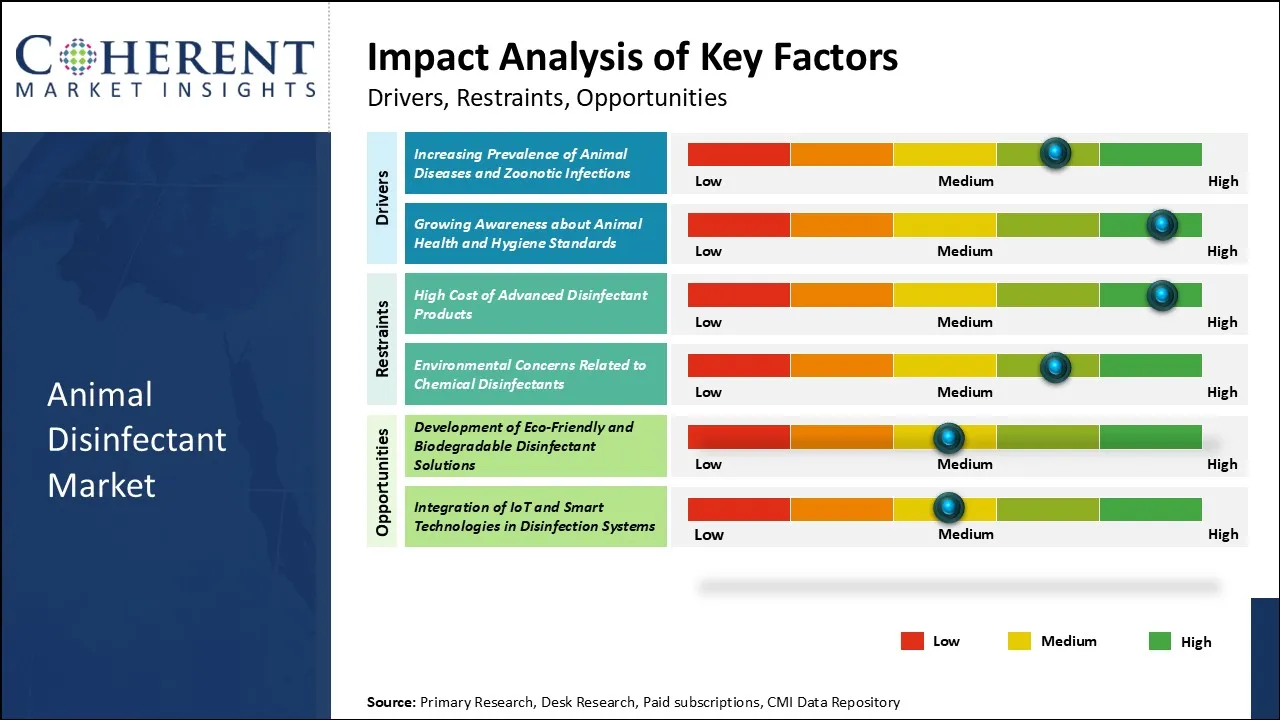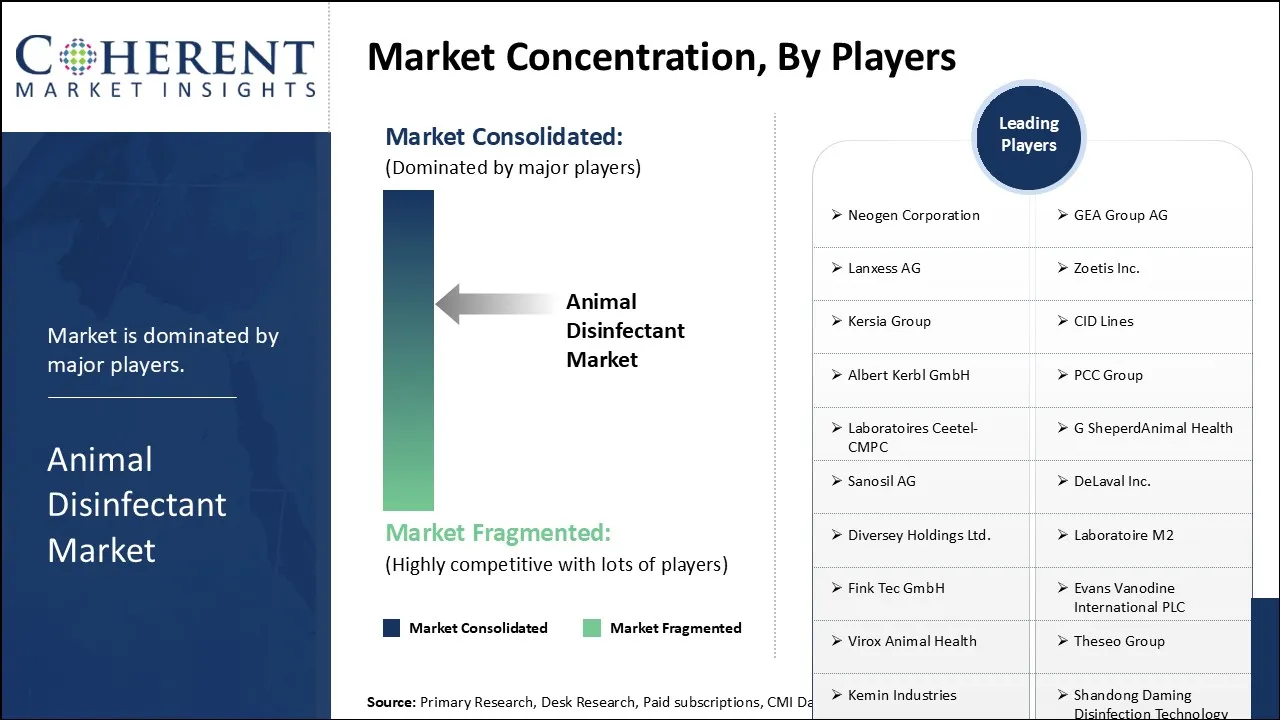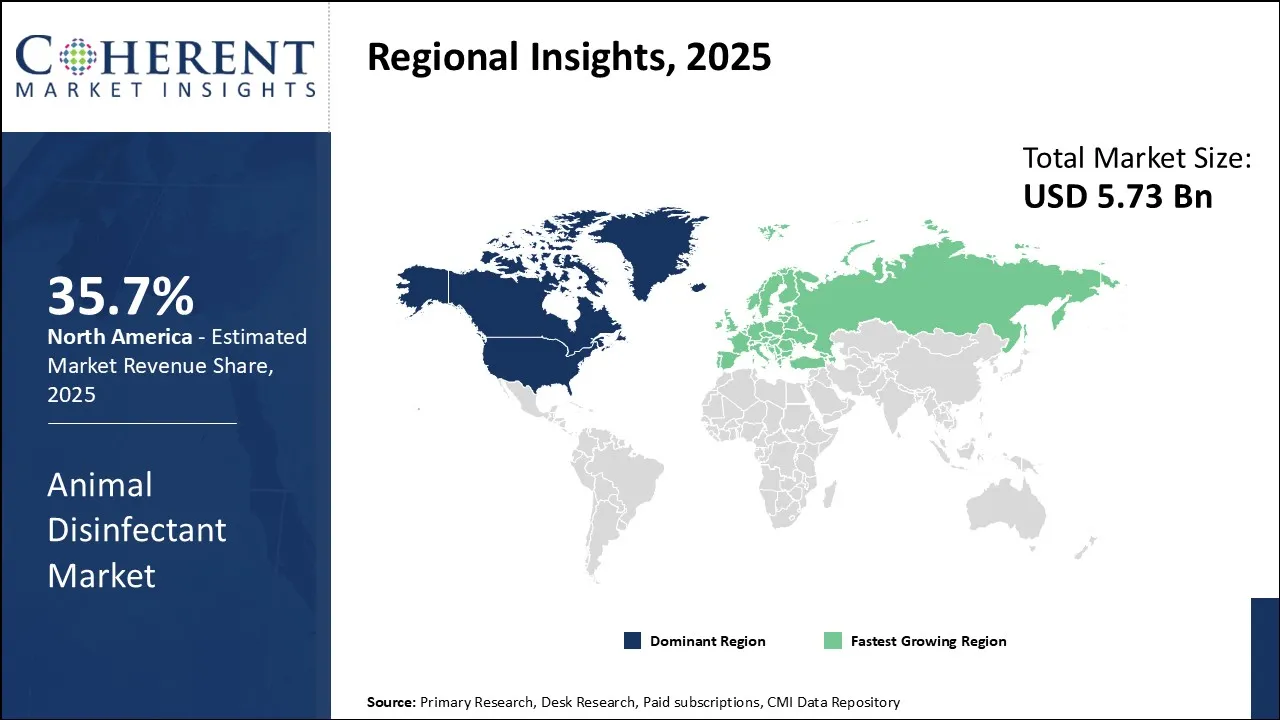The animal disinfectant market is estimated to be valued at USD 5.73 Bn in 2025 and is expected to reach USD 11.45 Bn by 2032, exhibiting a compound annual growth rate (CAGR) of 10.4% from 2025 to 2032.

To learn more about this report, Download Free Sample
Animal disinfectants help in killing fungi, bacteria, viruses, and other pathogens in animal veterinary clinics and livestock production premises, protect animals from the risk of infection, and prevent the transmission of diseases to humans. Animal disinfectants help in controlling the prevailing incidences of diseases in the livestock and help in the terminal disinfection of the premises. Moreover, the increase in consumer preferences for biological disinfectants also acts as a good opportunity for the global animal disinfectant market.
However, there is concern regarding the toxic effects of certain disinfectants on animals, the environment, and even human health which is hampering the market.

To learn more about this report, Download Free Sample
|
Current Events |
Description and its impact |
|
Global Animal Disease Outbreaks and Zoonotic Concerns |
|
|
Supply Chain Disruptions and Raw Material Price Volatility |
|
Uncover macros and micros vetted on 75+ parameters: Get instant access to report
The growing incidence of animal diseases—such as mastitis, avian influenza, and African swine fever—and zoonotic infections like Salmonella and E. coli is significantly boosting global demand for animal disinfectants. These threats not only impact livestock health and farm productivity but also pose serious public health risks.
For instance, according to the World Organization of Animal Health, animal diseases are spreading into new regions, and nearly 47% of them have zoonotic (animal-to-human) potential, underscoring the urgent need for robust biosecurity measures.
In terms of type, the iodine segment is expected to contribute 42.2% share of the market in 2025, owing to vast antimicrobial properties.
The sustained dominance of iodine in this space can be primarily attributed to its long-standing recognition as an effective antiseptic and disinfectant that balances efficacy with safety. The International Federation for Animal Health (IFAH) recognizes iodine’s prominent role in farm biosecurity measures globally, attributing its usage largely to the ability to reduce microbial load in animal premises, tools, and even on skin and hooves without causing significant irritation or toxicity.

To learn more about this report, Download Free Sample
North America is expected to be the largest market for animal disinfectant during the forecast period, accounting for over 35.7% of the market share in 2025. The large-scale presence of key industry players such as Ceva Innovative Disinfection (CID) Lines, Neogen Corporation, and Lanxess in the region has enabled strong supply chains and distribution channels for animal disinfectants. With the high emphasis on animal welfare and pet ownership in countries like the U.S., the demand for disinfectants to prevent spread of diseases among animals has remained steady.
For instance, according to a report by the Centers for Disease Control and Prevention, commercially available 3% hydrogen peroxide is a stable and effective disinfectant for inanimate surfaces, including those found in animal housing and veterinary clinics, helping to control the spread of pathogens among livestock and pets.
Asia Pacific market is expected to be the second-largest market for animal disinfectant, accounting for over 25.2% of the market share in 2025. The rapidly rising pet population and increased spending on pet care in countries such as India, China, Indonesia, and Australia are fueling demand. While sanitation and hygiene awareness levels are improving among pet owners, the risk of disease transmission still remains high in Asia Pacific due to factors like overpopulation and high density of livestock farming.
The U.S is the largest market for animal disinfectants globally, driven by its extensive livestock industry and high pet ownership rates. Strict regulations on animal health and welfare, coupled with increasing awareness of biosecurity, have fueled demand for advanced disinfectant solutions. Major companies like Ceva Innovative Disinfection (CID) Lines and Neogen Corporation are headquartered here, strengthening supply chains and innovation in disinfectant formulations for farms, veterinary clinics, and pet care.
China’s rapidly growing livestock industry and increasing government focus on controlling animal diseases have made it a key player in the animal disinfectant market. Large-scale outbreaks in recent years have prompted strict biosecurity measures, escalating the use of disinfectants in farms and slaughterhouses. China’s expanding middle class and rising pet ownership further boost the demand for effective animal hygiene products, encouraging both domestic production and international market entry.
Germany leads the Europe animal disinfectant market, supported by its strong agricultural sector and advanced veterinary infrastructure. The country’s stringent animal health regulations and commitment to sustainability encourage the adoption of eco-friendly and effective disinfectants. Germany also benefits from extensive R&D investments, fostering the development of novel biosecurity products that are widely used across livestock farms and food processing facilities.
Brazil is a dominant force in the Latin America animal disinfectant market due to its position as a global agricultural powerhouse with vast cattle, poultry, and swine populations. The country’s focus on preventing disease outbreaks like foot-and-mouth disease and avian influenza has led to increased use of animal disinfectants. Brazilian companies, along with international suppliers, provide a wide range of products tailored to the country’s diverse climate and farming practices, supporting both export-driven and domestic agricultural sectors.
|
Category, Product Examples |
Price Range |
|
Hydrogen Peroxide, Virbac Vétoquinol, Zoetis |
USD 10-USD 40/liter (concentrate) |
|
Quaternary Ammonium Compounds, Unilever Diversey, Ecolab |
USD 20-USD 50/liter |
|
Iodine-Based Disinfectants, Agro Pharma, Pfizer Animal Health |
USD 15-USD 35/liter |
|
Phenolic Acids, Lysol (surface wipes) |
USD 5-USD 15/surface wipe (pre-mixed) |
|
Chlorine-Based, Bleach solutions |
USD 5-USD 10/gallon (home use) |
|
Organic/Biodegradable, Biosecurity-focused products (e.g., Biomin) |
USD 30-USD 60/liter |
Uncover macros and micros vetted on 75+ parameters: Get instant access to report
|
Macro-Economic Factors |
Micro-Economic Factors |
|
Government Regulations and Biosecurity Mandates: Stricter animal health regulations and biosecurity protocols drive demand for disinfectants. For example, governments globally have enforced hygiene standards in livestock farming to prevent zoonotic disease outbreaks (e.g., avian influenza, foot-and-mouth disease). The U.S. Department of Agriculture and European Food Safety Authority mandates routine disinfection in farms and slaughterhouses, creating sustained demand. |
|
|
Global Health Trends and Disease Dynamics: Rising zoonotic diseases and climate-driven zoonotic spillover events fuel disinfectant adoption. Climate change alters disease vectors, increasing pathogen transmission between species. For instance, the global animal disinfectant market grew to USD 3.91 Bn in 2025 (vs. USD 3.62 Bn in 2024) due to biosecurity measures against emerging diseases. Example: Foot-and-mouth disease (FMD) outbreaks in Asia and Africa accelerate disinfectant use in livestock operations, a trend noted in market forecasts for 2029 (USD 5.38 Bn projected). |
|
Uncover macros and micros vetted on 75+ parameters: Get instant access to report
| Report Coverage | Details | ||
|---|---|---|---|
| Base Year: | 2024 | Market Size in 2025: | USD 5.73 Bn |
| Historical Data for: | 2020 To 2024 | Forecast Period: | 2025 To 2032 |
| Forecast Period 2025 to 2032 CAGR: | 10.4% | 2032 Value Projection: | USD 11.45 Bn |
| Geographies covered: |
|
||
| Segments covered: |
|
||
| Companies covered: |
Neogen Corporation, GEA Group AG, Lanxess AG, Zoetis Inc., Kersia Group, CID Lines, Albert Kerbl GmbH, PCC Group, Laboratoires Ceetel- CMPC, G SheperdAnimal Health, Sanosil AG, DeLaval Inc., Diversey Holdings Ltd., Laboratoire M2, Fink Tec GmbH, Evans Vanodine International PLC, Virox Animal Health, Theseo Group, Kemin Industries, and Shandong Daming Disinfection Technology Co. Ltd. |
||
| Growth Drivers: |
|
||
| Restraints & Challenges: |
|
||
Uncover macros and micros vetted on 75+ parameters: Get instant access to report
*Definition: Animal disinfectants help in killing fungi, bacteria, viruses, and other pathogens in animal veterinary clinics and livestock production premises, and protect animals from the risk of infection as well as prevent the transmission of diseases to humans. Animal disinfectants help in controlling the prevailing incidences of diseases in the livestock and help in terminal disinfection of the premises. These disinfectants help to curb potential outbreaks, and thus help in driving the market growth. Moreover, increase in the consumer preferences for biological disinfectants also act as a good opportunity for the global animal disinfectant market.
Share
Share
About Author
Ghanshyam Shrivastava - With over 20 years of experience in the management consulting and research, Ghanshyam Shrivastava serves as a Principal Consultant, bringing extensive expertise in biologics and biosimilars. His primary expertise lies in areas such as market entry and expansion strategy, competitive intelligence, and strategic transformation across diversified portfolio of various drugs used for different therapeutic category and APIs. He excels at identifying key challenges faced by clients and providing robust solutions to enhance their strategic decision-making capabilities. His comprehensive understanding of the market ensures valuable contributions to research reports and business decisions.
Ghanshyam is a sought-after speaker at industry conferences and contributes to various publications on pharma industry.
Missing comfort of reading report in your local language? Find your preferred language :
Transform your Strategy with Exclusive Trending Reports :
Frequently Asked Questions
Joining thousands of companies around the world committed to making the Excellent Business Solutions.
View All Our Clients